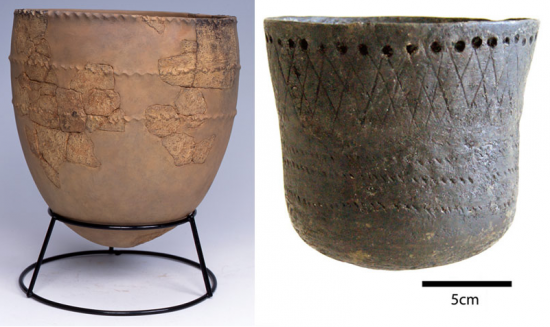University of York
Source - http://www.eurekalert.org/pub_releases/2013-04/uoy-pri040913.php

Credit: (left)Tokamachi City Museum; (right) Wakasa History and Folklore Museum, Fukui, Japan
Hunter-gatherers living in glacial conditions produced pots for cooking fish, according to the findings of a pioneering new study led by the University of York which reports the earliest direct evidence for the use of ceramic vessels.
Scientists from the UK, the Netherlands, Sweden and Japan carried out chemical analysis of food residues in pottery up to 15,000 years old from the late glacial period, the oldest pottery so far investigated. It is the first study to directly address the often posed question "why humans made pots?" The research is published in Nature.
The research team was able to determine the use of a range of hunter-gatherer "Jōmon" ceramic vessels through chemical analysis of organic compounds extracted from charred surface deposits. The samples analysed are some of the earliest found in Japan, a country recognised to be one of the first centres for ceramic innovation, and date to the end of the Late Pleistocene - a time when humans were adjusting to changing climates and new environments.
Until quite recently ceramic container technologies have been associated with the arrival of farming, but we now know they were a much earlier hunter-gatherer adaptation, though the reasons for their emergence and subsequent widespread uptake are poorly understood. The first ceramic containers must have provided prehistoric hunter-gatherers with attractive new ways for processing and consuming foods but until now virtually nothing was known of how or for what early pots were used.
The researchers recovered diagnostic lipids from the charred surface deposits of the pottery with most of the compounds deriving from the processing of freshwater or marine organisms. Stable isotope data support the lipid evidence, and suggest that the majority of the 101 charred deposits, analysed from across Japan, were derived from high trophic level aquatic foods.
Dr Oliver Craig, of the Department of Archaeology and Director of the BioArCh research centre at York, led the research. He said: "Foragers first used pottery as a revolutionary new strategy for the processing of marine and freshwater fish but perhaps most interesting is that this fundamental adaptation emerged over a period of severe climate change.
"The reliability and high abundance of food along shorelines and river-banks may well have provided the initial impetus for an investment in producing ceramic containers, perhaps to make the most of seasonal gluts or as part of elaborate celebratory feasts and could be linked to a reduction in mobility.
This initial phase of ceramic production probably paved the way for further intensification in the warmer climate of the Holocene when we see much more pottery on Japanese sites.
"This study demonstrates that it is possible to analyse organic residues from some of the world's earliest ceramic vessels. It opens the way for further study of hunter-gatherer pottery from later periods to clarify the development of what was a revolutionary technology."
###
The study also involved researchers from Archaeological Sciences, University of Bradford; Division of Chemistry and Environmental Sciences, Manchester Metropolitan University; School of Environmental Sciences, University of Liverpool; Department of Archaeology, University of Aberdeen; Centre for the Study of Cultural Evolution, Stockholm University; The Archaeological Research Laboratory, Department of Archaeology and Classical Studies, Stockholm University and Arctic Centre, University of Groningen, Netherlands; and Niigata Prefectural Museum of History, Niigata; Research Institute for Humanity and Nature, Kyoto and Wakasa History and Folklore Museum, Fukui, in Japan.
The research was supported by the Leverhulme Trust and Japanese Society for the Promotion of Science.
Earliest evidence for the use of pottery
O. E. Craig, H. Saul, A. Lucquin, Y. Nishida, K. Taché, L. Clarke, A. Thompson, D. T. Altoft, J. Uchiyama, M. Ajimoto, K. Gibbs, S. Isaksson, C. P. Heron & P. Jordan
Source - http://www.nature.com/nature/journal/vaop/ncurrent/full/nature12109.html
Nature (2013) doi:10.1038/nature12109
Pottery was a hunter-gatherer innovation that first emerged in East Asia between 20,000 and 12,000 calibrated years before present1, 2 (cal BP), towards the end of the Late Pleistocene epoch, a period of time when humans were adjusting to changing climates and new environments. Ceramic container technologies were one of a range of late glacial adaptations that were pivotal to structuring subsequent cultural trajectories in different regions of the world, but the reasons for their emergence and widespread uptake are poorly understood. The first ceramic containers must have provided prehistoric hunter-gatherers with attractive new strategies for processing and consuming foodstuffs, but virtually nothing is known of how early pots were used. Here we report the chemical analysis of food residues associated with Late Pleistocene pottery, focusing on one of the best-studied prehistoric ceramic sequences in the world, the Japanese Jōmon. We demonstrate that lipids can be recovered reliably from charred surface deposits adhering to pottery dating from about 15,000 to 11,800 cal BP (the Incipient Jōmon period), the oldest pottery so far investigated, and that in most cases these organic compounds are unequivocally derived from processing freshwater and marine organisms. Stable isotope data support the lipid evidence and suggest that most of the 101 charred deposits analysed, from across the major islands of Japan, were derived from high-trophic-level aquatic food. Productive aquatic ecotones were heavily exploited by late glacial foragers3, perhaps providing an initial impetus for investment in ceramic container technology, and paving the way for further intensification of pottery use by hunter-gatherers in the early Holocene epoch. Now that we have shown that it is possible to analyse organic residues from some of the world’s earliest ceramic vessels, the subsequent development of this critical technology can be clarified through further widespread testing of hunter-gatherer pottery from later periods.

Bulk carbon and nitrogen stable isotope ratios and fatty acid stable carbon isotope ratios from Incipient Jōmon pottery.